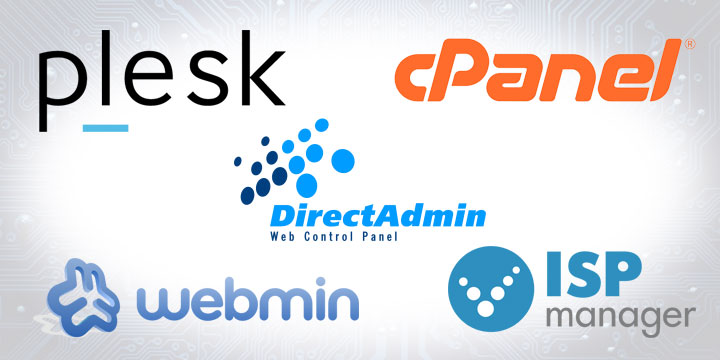
Top 5 VPS Control Panels
Posted July 28, 2016 by Unlimited
Many of our VPS clients are looking for the simplest way to manage their servers. Here at Unlimited Web Hosting we offer a choice of three GUI (Graphical User Interface) based control panels, with the option to install a third party control panel of your choice.
In this blog post we will be looking at the three control panels we provide, and an additional two alternative control panels to consider.
First, let’s take a look at some common features that are provided by control panels.
General Features of Control Panels
Many control panels provide the majority, if not all, of the following features:
- Plugin management system, for installing applications and services on your server.
- Access to your servers logfile and error reporting
- Backup management
- Database management (Usually MySql but sometimes including other database systems)
- User and key management for SSH (Secure Shell)
- Access to the file system via a web-based interface
- FTP management, including setting up users, password management and file system settings
- Email management, including creating email addresses, quotas and spam prevention
- Domain name management, including web domains, sub domains and mail domains
Enterprise Features of Control Panels
Some control panels also provide enterprise level features, these are typically features that are aimed at higher level users. They can include:
- Management for multiple servers from a single control panel
- Ability for hosts to let multiple customers run control panel software on a server in parallel
- Monitoring of services with alerts
- Ticketing systems to enable customers to report issues
- Support for IPv6
Comparison of Control Panel Specifications
The table below gives you a side by side comparison of the specifications of the control panels we will be looking at.
| Control Panel | Open-source | Linux | Windows | DNS | FTP | Databases | IPv6 | Multi-server | |
|---|---|---|---|---|---|---|---|---|---|
| cPanel | No | Yes | No | Yes | Yes | Yes | Yes | Yes | Yes |
| Plesk | No | Yes | Yes | Yes | Yes | Yes | Yes | Yes | Yes |
| Webmin | Yes | Yes | No | Yes | Yes | Yes | Yes | Yes | Yes |
| DirectAdmin | No | Yes | No | Yes | Yes | Yes | Yes | Yes | No |
| ISPmanager | No | Yes | No | Yes | Yes | Yes | Yes | Yes | Yes |

cPanel and cPanel WHM
cPanel is the most popular control panel on the web, and is used by clients to maintain their sites and also by hosting providers to administer their clients accounts.
cPanel is the control panel that is used by site owners to manage their web sites, while cPanel WHM is the control panel that is used by hosting providers as a server administration tool.
Both cPanel and WHM are generally considered to have the most features of all current control panels, and although they don’t offer Windows support out-of-the-box, it can be achieved by using either a virtualisation setup or using their Enkompass product.
A common complaint with cPanel is that although the interface is fairly easy to use, it is not the best or most intuitive that is available.
You can read more about cPanel and WHM on their website.

Plesk
The Plesk control panel is a popular interface that supports a number of different versions of Linux and also features Windows compatibility.
The GUI is considered to be cleaner and more intuitive than cPanel, and Plesk has only slighter fewer features than cPanel.
For developers, the Plesk control panel has support for a number of PHP versions out-of-the-box. Also, Ruby Python and NodeJS support is available via Phusion, and a number of popular Linux distros are supported, including CloudLinux, Ubuntu, CentOS and Debian.
You can read more about Plesk on their website.

Webmin
Webmin is a feature packed open-source control panel that allows you to perform the majority of the tasks you would perform by command line, but in a GUI. Webmin can be used on Linux servers only, and contains dozens of modules for configuring server services.
Webmin’s Cloudmin tool is used for the management of virtual systems, including OpenVZ, KVM and Xen.
While powerful, Webmin is not as easy to use as cPanel or Plesk, and tends to be recommended for more experienced users. Beyond basic settings, Webmin does require a good working knowledge of Linux.
Webmin’s plus point is its ability to handle a broad range of tasks, from basic to complex.
You can read more about Webmin on the Webmin website.

DirectAdmin
DirectAdmin is lightweight control panel that supports Linux only. It has all of the basic features that you would expect of a control panel, including multi-customer support. All of the paid for versions of DirectAdmin come with technical support and unlimited domains.
Out-of-the-box, DirectAdmin offers 3 levels of access: admin, reseller and user. A fourth level can be added via an official free plugin that will allow email access.
Some of DirectAdmin’s features include:
- Management for multiple servers from a single control panel
- Ability for hosts to let multiple customers run control panel software on a server in parallel
- Monitoring of services with alerts
- Ticketing systems to enable customers to report issues
- Support for IPv6
You can find out more about DirectAdmin at the DirectAdmin website.

ISPmanager
ISPmanager supports Linux-based systems, and is developed by ISPsystem, a leading automation provider for Russia. ISPmanager has grown over the last two decades to become one of the most popular control panels in Eastern Europe, and it is gaining popularity in other territories too.
There are two editions that are offered, both of which can be customised to match the clients branding and both of which can handle unlimited users and domains.
The first, ISPmanager Lite is aimed at managing dedicated servers or virtual private servers. Secondly, ISPmanager Business is designed for shared and reseller hosting.
While ISP manager is a commercial control panel, it shares features with some premium control panels at a lower price. The rich features and competitive pricing of ISPmanager make it an attractive choice for users.
You can find out more about ISPmanager at the ISPmanager website.
Conclusion
At Unlimited Web Hosting we offer a choice of Plesk or cPanel with your Virtual Private Server Hosting package. There are many other third party control panels that are available, and the panel you choose is largely down to your own requirements.
If you would like to know more about VPS Hosting then visit our VPS Hosting page, or contact us to discuss your requirements.
Categories: cPanel, Plesk, VPS Hosting


